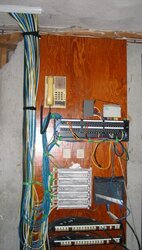Gooserider
Mod Emeritus
d.n.f. said:Sorry for the hijack, but why low voltage box only? I used a metal box and it has openings top and bottom with tons of room for wire/coax to go through.
I understand the kinking issue but is there a problem I need to know about for using a metal box? I am about to close it up and now would be the time.
I don't know of a specific reason NOT to use a metal box, except that the box should NOT be connected to an AC ground (and it is ABSOLUTELY prohibited for AC and Low voltage to be in the same box unless it's divided by a solid partition) Code doesn't (that I know of) absolutely prohibit use of AC boxes, conduit, etc. with low voltage equipment, but it is frowned upon. Part of this is color coding to tell anyone working on the stuff whether it's AC or low voltage, which is why low voltage boxes, etc. are normally orange, while AC stuff is blue.
The problem with any solid back box is clearance for the bend radius, especially on coax type cables - there is BARELY enough room for a proper bend in the full width of standard 2 x 4 wall construction. Bending coax to sharply can cause the inner dielectric to be distorted, and allow the center conductor to get to close to the shield, even though it doesn't short, this will still have a negative impact on the higher frequency transmission characteristics of the line - iow, you get subtle reception problems on the TV...
Kinking and tight bends on CAT5 aren't as catastrophic, but they still aren't good - again that is a wire which has critical design parameters that depend on the exact spacing of the conductors, the differing twist rates of the pairs, and so on. Doing computer grade cabling is fussy if you want to do it properly, as the designs are pushing the limits of the laws of physics in order to get the performance out of the equipment, and deviations from the standards will cause performance issues even though low frequency / DC continuity checks may pass....
Gooserider



